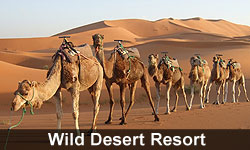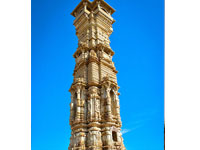| |
|
| |
Wild Desert Resort |
|
|
|
|
|
|
| |
 |
|
| |
| |
An Adventure on sand dunes and same. get a feel of shifting sand dunes Capturing the spirit of Sand Dunes and ensuring the perfect Dunes experience at Wild desert resort, a unique Sam Dunes Resort and Camp. |
|
|

|
|
|
|
|
|
|
| Chittorgarh |
Chittorgarh Fort
 The Chittorgarh Fort seated on a 180 metre hill, covers an expanse of 700 acres (2.8 km2). It was constructed by the Mauryans in the 7th century AD. There is also a belief that it was constructed by Bhima of the Pancha Pandavas. This fort was the citadel of many great Indian warriors such as Gora, Badal,Rana Kumbha, Maharana Pratap, Jaimal, Patta, etc.
The Chittorgarh Fort seated on a 180 metre hill, covers an expanse of 700 acres (2.8 km2). It was constructed by the Mauryans in the 7th century AD. There is also a belief that it was constructed by Bhima of the Pancha Pandavas. This fort was the citadel of many great Indian warriors such as Gora, Badal,Rana Kumbha, Maharana Pratap, Jaimal, Patta, etc.
 Vijay Stambh Vijay Stambh
Vijay Stambha, is a huge nine storey tower which was built by Maharana Kumbha to commemorate his victory over the Muslim rulers of Malwa and Gujarat in 1440. The tower is 122 ft (37 m) high and stands on a 10 ft (3.0 m) high base. There are sculptures and carvings on the exterior walls of the tower. The tower is visible from any section of the town below. And for reaching tower top one have to climb 157 steps, one can take great view of the surroundings. The inside walls of the tower are carved with images of Gods, weapons, etc.
 Kirti Stambh Kirti Stambh
Kirti Stambh is tower is dedicated to Rishabha, the first Tirthankara of Jainism. It was built by a merchant and is decorated with figures form the Jain pantheon.It is a seven storied pillar which was build by Biherwal Mahajan Sanaya of Digambar Jain sect during 12th century AD. On its four corners are engraved idols of Shri Adinathji in Digambar style which each are five feet (about 1.5meters) high and elsewhere are engraved several small idols consecrated to Jain lineage of deities.
 Kalika Mata Temple Kalika Mata Temple
Kalika Mata Temple was originally built in the 8th century for Sun God and was later converted to a temple for mother Goddess, Kali in the 14th century.During the festival days of Navaratri, fairs are organised and pilgrims from different places come here to pay obeisance at the temple.
Rani Padmini's Palace
Rani Padmini's Palace is from which Alauddin Khilji (one of the rulers of Khilji dynasty during the sultanate rule over India) was allowed to watch a reflection of the Rani by replacing the mirror at such an angle that even if he turned back he could not see the room. Khilji had been warned by the Rani's husband Rawal Ratan Singh that if he turned back they would cut his neck.
Sikkim by Road:
National Highway no. 31 serves as a connecting link between the state capital Gangtok and Siliguri, one of the major towns on the northern fringe of West Bengal. Gangtok is also well connected to Kolkata (721 km) and Darjeeling (139 km) with a good network of roads. Kalimpong is another well connected destination with Gangtok. However the NH no. 31 is the most famous route between Gangtok and Siliguri. There are regular buses plying between Siliguri to Sikkim and vice versa. Tourists can reach various towns of Sikkim through easily available cabs/taxi.
By bus :
Rajasthan roadways (RSRTC) provide a very good service for visiting areas around Chittorgarh. Rajasthan Roadways also has a premier service called Pink Line, Silver line and Sleeper Coaches (Gray Line).
For more detail about Rajasthan Roadways service please call on following numbers:
General Enquiry : 01472 - 241177
Station Master : 01472 - 241038
Private Bus Services : Numbers of private bus services are available in Chittorgarh, connecting all major cities in India.
By Rbyailby rail :
By rail :
Chittorgarh railway station is a busy junction of western indian railways. It has direct rail links with all major north Indian cities including Mumabi, Delhi, Ahmedabad, Ajmer, Udaipur, Jaipur and Kota.
By air
The nearest airport is Udaipur (Dabok Airport). The airport is located 70 kilometers from Chittorgarh and linked by daily Air Service from New Delhi, Jaipur, Jodhpur, Ahmedabad and Mumbai.
Jaipur (Sanganer) Airport is located 300 Km north from Chittorgarh and also well connected though buses, taxis and regular trains.
Festivals :
Elephant Festivals
The elephant Festival gets underway in the north of Phalgun (March) on the eve of Holi, the festival of colours, at Jaipur. The elephants enthrall the spectators on the day of the colorful festival of Holi at Chaugan stadium. Beautifully decorated elephants assemble for a royal procession. Elephant polo, the races etc. are part of the festival.
Gangaur Festivals
A festival devoted to Godess Parvati, the consort of Lord Shiva. It is a time for young girls to dress up in their finery and pray for grooms of their choice while the married women pray for the well-being of their husbands. This 18-day festival is laced with various activities and culminates in a grand procession marking the arrival of Lord Shiva to escort his bride home.
Teej Festival
This festival marks the onset of the rains. The monsoons bring water to the parched land and women celebrate by singing and swinging on swings hung from trees. The festival is dedicated to Goddess Parvati and an elaborate procession is taken out in Jaipur for two consecutive days.
Camel Festival (January)
Camels, the stalwarts of the desert, put up an unmatched performance during the festival, bringing the desert town to life with their spellbinding display of graceful parades and stunning feats. The festival sways to the sound of melodious music created by the folk performers. Various camel contests are held during the festivals.
Karni Mata Fair (April/ May and Oct. / Nov.)
The fair is celebrated twice a year in the little desert citadel of Deshnoke, in honour of Godness Karni Mata, the tutlary deity of the Bikaner royal house. The devtees gather at deshnoke during the navratra, in April/May and October/ November and the fair is held on the ninth day of navratra, amidst the chanting of hymns and prayers. Devotees offers puja and the celebrations have a distinct religious flavour.
|
|
|


